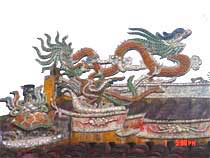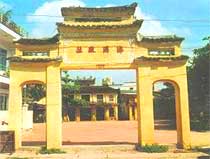The village communal house, especially in Northern Vietnam, is a rich treasure trove of Vietnamese sculpture throughout history. Sculpture also exists in temples, shrines, and other religious architectures, but nowhere is it expressed as fully as in the communal house. The sculpture in the communal house not only serves as a valuable resource for studying the history of Vietnamese fine arts but also provides insights into the everyday lives and souls of Vietnamese farmers.
 |
|
An Hai Communal House |
Discussing communal house sculpture also means discussing the art of decorating communal houses. Here, sculpture refers to decorative carving. The craftsmen who build the communal houses are not only skilled in construction but also know how to embellish the house to enhance its beauty. Therefore, the sculpture is closely linked to the architecture. Almost every component of the communal house architecture has been intricately carved by skilled artisans, creating artistic motifs that attract visitors’ attention when they visit the house.
Even the communal houses from the 16th to the 18th centuries display decorative sculpture that is heavily influenced by folk art. Anonymous sculptors, often from farming backgrounds, have infused the communal houses with images that resonate closely with their everyday lives and dreams, showcasing a truly unique style and vibrant spirit.
Unlike other religious architectures, even in the sacred spaces of the communal house, one may encounter playful representations of young couples teasing each other or expressing affection… By the 19th century, village communal house sculpture had largely ceased to depict scenes of everyday life. From this point on, only decorative motifs of foliage remained, with the most common being the Four Sacred Animals (dragon, unicorn, turtle, phoenix). In 19th-century communal houses, there were often elaborately carved curtain doors in front of the worship hall.
 |
|
Hai Chau Communal House |
In the central region’s communal houses, the decorative sculpture is not as rich as in the northern communal houses. Some have summarized the wood decoration in the communal houses of Thua Thien – Hue: “In the wooden structure of the interiors, depending on the aesthetic concept, villagers may carve details of dragon heads and tails at the ends of the beams, floral motifs, and central lines on the wooden strips and supports. The more intricate carving is suited for communal houses with moderate, elegant structures, while less carving is appropriate for larger, more massive wooden structures…” This is also the general decorative characteristic of communal houses in the central region. However, while wooden decorative sculpture may have diminished, the communal houses in Central Vietnam have developed an approach to decoration using plaster reliefs and affixing ceramic pieces to the exterior of the architecture. Typically, on the roof ridges and edges, the Four Sacred Animals are depicted. At both ends of the gables, bat motifs spread their wings made from ceramics are used to symbolize good fortune. This was a common decorative style during the Nguyen dynasty.
Southern communal houses also feature exterior relief decorations similar to those in the central region, but the wooden decorative sculptures have their unique differences. Most of this wood carving dates back to the mid-19th century. The four pillars of the communal house are often adorned with dragon motifs, referred to as “dragon pillars.” In many places, the dragon pillars are separately carved and attached, while in others, they are carved as a single block… In addition to the dragon pillars, Southern communal houses often have decorative beams in front of the worship hall, akin to the curtain doors in Northern communal houses, intricately carved with themes such as the Four Sacred Animals, transformation of fish into dragons, and motifs of dragons and tigers…
Thus, decorative sculpture, along with architecture, has given communal houses their distinctive features throughout the country.


















































